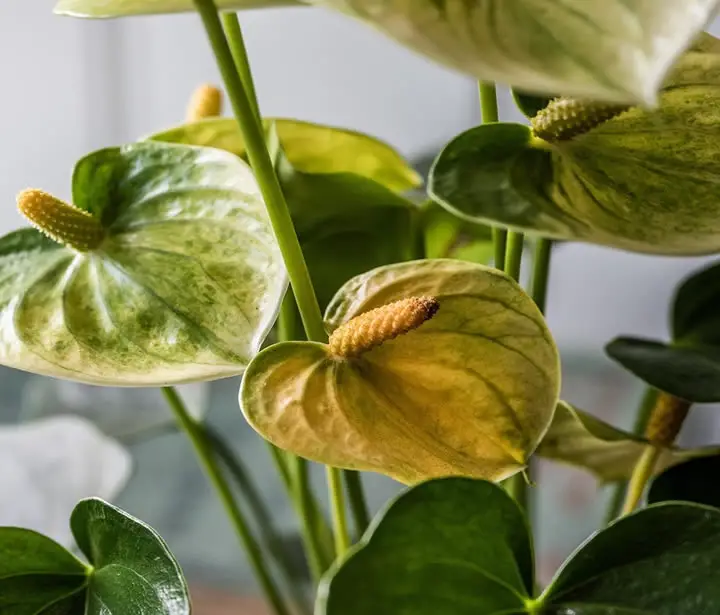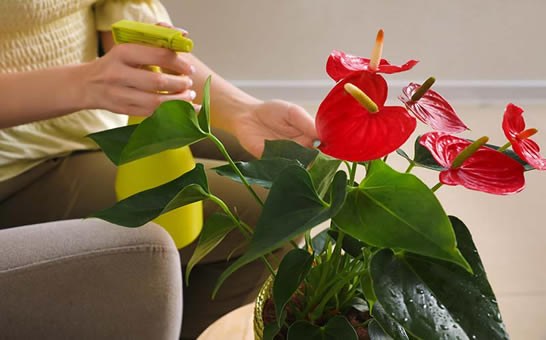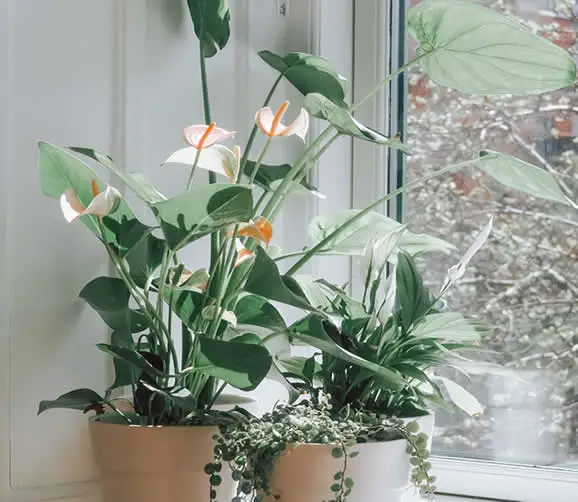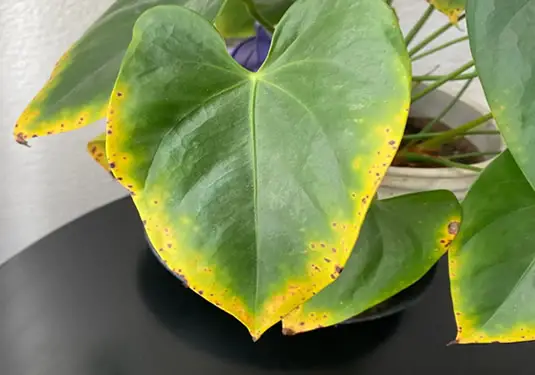Anthuriums are known for their stunning, lush green leaves and vibrant red flowers, but when those leaves start turning yellow, it’s a clear sign that something’s not right. While color changes are common in plants, particularly those grown in containers, yellowing leaves usually indicate environmental stress.
Understanding what’s causing the yellowing and how to create the best conditions for your plant can help you fix the issue and keep your Anthurium thriving.
Table of Contents
Why Are My Anthurium Leaves Turning Yellow?
Several factors can cause your Anthurium leaves to turn yellow, including:
- Overwatering
- Low humidity
- Excess sunlight
- Temperature stress
- Poor soil quality
- Insufficient fertilizer
The good news is that identifying the specific cause is key to fixing the issue.
Once you know the cause, you can take the necessary steps to restore your plant to its vibrant, healthy self.
This article will help guide you through diagnosing the problem and creating the perfect habitat for your Anthurium to thrive for years to come.
Anthurium Leaves Turning Yellow and What You Can Do
Anthurium plants are native to tropical regions, where they naturally grow by attaching to trees and branches rather than rooting directly in the soil.

With their glossy green leaves and vibrant flowers, these plants have become a popular choice for indoor gardening.
When cared for in the right conditions, they can thrive and add beauty to your home for years.
However, when you notice your Anthurium’s leaves turning yellow, it can diminish the plant’s striking appearance.
The good news is that understanding the common causes of yellowing leaves—and how to fix them—can help you restore your plant’s health and bring back its lush, green foliage.
Environmental Stress and Your Anthurium Plant
The most common reasons for yellowing Anthurium leaves are improper watering or too much light.
These two factors can lead to a condition called chlorosis, which is the breakdown of chlorophyll in the plant’s leaves.
When your Anthurium receives too much water or is exposed to excess sunlight, it produces less chlorophyll, and the existing chlorophyll begins to degrade.
This results in unhealthy, yellow or brown leaves (see our article on treating an anthurium with browning leaves).
Other stressors, such as poor nutrition, inadequate soil drainage, and low humidity, can also contribute to yellowing leaves.
Recognizing which factor is at play will help you address the issue and get your plant back to its healthy, glossy self.
1. Over-Watering: The Most Common Cause of Anthurium Leaves Turning Yellow
Anthurium plants thrive in moderately moist soil, which should never become soggy.
When the soil stays too wet, it compromises the plant’s root system, causing poor aeration and root rot.
As a result, your plant becomes stressed, leading to yellow or brown leaves, as well as faded flowers and bracts.

However, over-watering is more than just watering too often. It’s about ensuring the right balance of moisture—keeping the soil lightly moist without it becoming overly saturated.
This is especially important because standing water can encourage root rot, which further damages the plant.
To avoid over-watering:
- Always check if the top 1–2 inches of the soil feel dry before watering.
- Ensure your pot has adequate drainage to allow water to escape.
- Never let water sit in the saucer beneath the pot.
- Follow a watering schedule, but adjust based on your plant’s needs and the conditions in your home.
Properly mastering the art of watering will keep your Anthurium healthy and prevent yellow leaves.
2. Improper Humidity Levels
Anthuriums are native to tropical regions, where they thrive in high humidity.
Indoor environments, especially in homes with central heating, can have much lower humidity, which can lead to yellowing leaves.
This problem worsens during winter when we turn on the heating and close windows, creating dry air that doesn’t support tropical plants.
How to Fix Low Humidity for Your Anthurium:
- Move your plant to a more humid area, such as a bathroom.
- Use a humidity tray placed beneath the plant or nearby to increase moisture in the air.
- Group your plants together to create a humid microenvironment.
- Invest in a humidifier to maintain consistent humidity levels.
- Mist your plants lightly to add moisture, though be cautious, as excessive misting can lead to mold or mildew in poorly ventilated areas.
By maintaining a humidity level that mimics its native environment, your Anthurium will thrive, with healthier foliage and vibrant blooms.
3. Anthurium Leaves Turning Yellow Due to Poor Nutrition
Anthuriums are relatively low-maintenance when it comes to fertilizing, but they do require some nutrition to maintain their lush foliage and beautiful blooms.
If your Anthurium’s leaves are turning yellow, a lack of essential nutrients could be the culprit.
If you haven’t been fertilizing your Anthurium, start applying a water-soluble fertilizer once a month, with a balanced formula that includes added phosphorus to encourage blooms.
How to Fertilize Your Anthurium:
- Apply fertilizer at 1/4 of the recommended strength—indoor plants usually require less than outdoor plants.
- Use a high quality succulent fertilizer. I’ve found that orchid feed works really well for enhancing the color of this flamingo flower.
- Over-fertilizing can lead to nutrient toxicity, where excess nutrients build up and prevent the plant from absorbing others, causing yellowing leaves and damage to the roots.
If you’ve been over-fertilizing:
- Stop fertilizing immediately.
- Flush the soil thoroughly with water to remove excess fertilizer.
- Leave the plant without feeding for a couple of months to allow it to recover.
By following a balanced feeding schedule, your Anthurium can maintain its health and vibrant leaves.
4. Poor Soil Quality
Soil that doesn’t drain well can cause poor aeration for the roots and increase the risk of root rot, which often leads to yellowing leaves.
Also, nutrient-deficient soil can result in a lack of essential elements for the plant, causing chlorosis (yellowing) of the leaves.
How to Improve Soil Quality:
- Repot your Anthurium into a well-draining mix, such as:
- Peat
- Pine bark
- Perlite
This combination creates a slightly acidic soil with good drainage and just the right amount of nutrients for your Anthurium to thrive.
5. Too Much Sunlight
Anthuriums do not thrive in direct sunlight, even though many people assume houseplants prefer it.
These plants are native to tropical regions where they grow beneath trees, only receiving indirect sunlight.

Excessive sunlight can cause the leaves to turn yellow and, in extreme cases, result in brown edges or sunburn marks.
How to Fix Too Much Sunlight:
Move your Anthurium to a spot with indirect light.
Ideal locations include:
- North, West, or East-facing windows.
- If your plant is near a South-facing window, ensure it is shaded or kept away from the direct rays.
On the flip side, too little light can cause dark green leaves and prevent the plant from blooming.
Make sure your Anthurium gets enough light for healthy growth and flower production.
These adjustments to your plant’s environment can help reverse the yellowing of leaves and bring your Anthurium back to health!
6. Temperature Stress
Anthuriums prefer warm temperatures between 70-85°F (21-29°C).
When exposed to cooler temperatures, your plant may experience stress, leading to chlorosis (yellowing) in the leaves.
Chlorosis happens when the plant’s chlorophyll breaks down, which affects the plant’s ability to produce energy and can result in spotty leaves.
For optimal growth, the minimum temperature should be 61°F (16°C), especially for flower production and healthy root growth.
How to Prevent Temperature Stress:
Keep your Anthurium away from extremes like:
- Cold air conditioning vents.
- Hot radiators or heating vents.
- Ensure the temperature remains consistent to avoid stressing your plant.
By maintaining the right temperature, your Anthurium can thrive and avoid yellowing leaves caused by temperature-related stress.
Anthurium Plant Care: 6 Steps To A Thriving Indoor Plant
If you want your Anthurium to thrive, it’s all about creating the right environment.
With the proper water, nutrients, sunlight, and temperature, your plant will stay healthy and vibrant.
Here’s a quick guide to ensure your Anthurium stays happy and you avoid dealing with yellow leaves.
1. Temperature:
Anthuriums are happiest in temperatures between 70-85°F (21-29°C). Keep them in this sweet spot for optimal health, and they’ll reward you with lush growth.
2. Soil:
Well-drained soil is key to preventing root and stem rot. A mix of equal parts peat moss, pine bark, and perlite is ideal for your Anthurium. This allows water to flow through while still holding enough moisture for your plant.
3. Light:
Bright, indirect light is the best option for your Anthurium. Avoid direct sunlight, as it can scorch the leaves and cause stress to the plant.
4. Humidity:
Anthuriums are native to tropical climates, so they love high humidity. Make sure your plant gets enough moisture in the air, especially during the drier months or in low-humidity homes.
5. Fertilization:
During the growing season, fertilize your Anthurium once a month with a water-soluble fertilizer. Dilute it to 1/4 strength to avoid overfeeding, which can harm the plant.
6. Maintenance:
Keep your Anthurium looking its best by removing dead or yellowing leaves. This helps encourage new growth and keeps the plant looking fresh.
7. Pot Size:
When it comes to pots, go with one that’s just a little larger than your plant’s root system. This helps reduce the risk of overwatering, which can lead to root rot.
By following these simple care tips, your Anthurium will stay healthy and vibrant for years to come.
If you need more detailed advice, I’ve got a full Anthurium care guide to help you master every aspect of growing this beautiful plant.
A Word About Seasonal Watering for Your Anthurium
Your Anthurium’s water needs change with the seasons.
During winter, growth slows down significantly, and your plant won’t need as much water as it does in the warmer months.

In summer, the higher temperatures increase both soil evaporation and transpiration from the leaves, so your plant will likely need more frequent watering.
Always check the soil before watering to make sure it’s not too wet or dry.
Tips for Repotting Your Anthurium
When it’s time to repot, make sure to water your Anthurium thoroughly before you start.
This helps loosen the roots, making them easier to remove from the old pot.
Choose a new container that’s just a bit larger than the old one—this prevents excess water retention.
A porous clay pot with drainage holes is a great choice. Terracotta pots are an excellent choice.
For the soil, go with a well-draining mix, such as a combination of peat, pine bark, and perlite.
Why Aren’t My Anthurium Flowers Crimson Red?
If your Anthurium flowers aren’t the vibrant crimson you expected, stress could be the culprit.
Factors like improper watering, too much or too little light, excessive fertilizer, low humidity, and wrong temperatures can cause the flowers to turn yellow or green.
By following proper care guidelines, you’ll give your plant the best chance to produce those beautiful red blooms!

